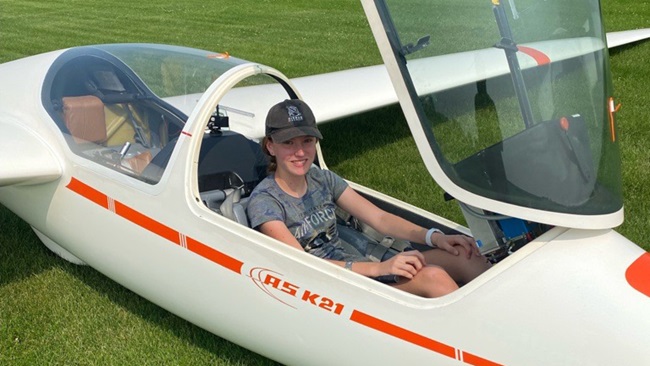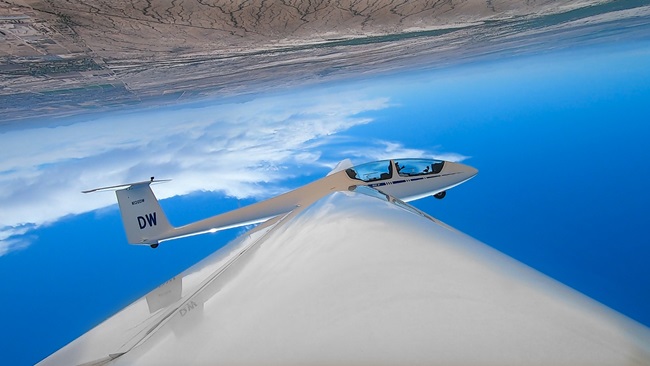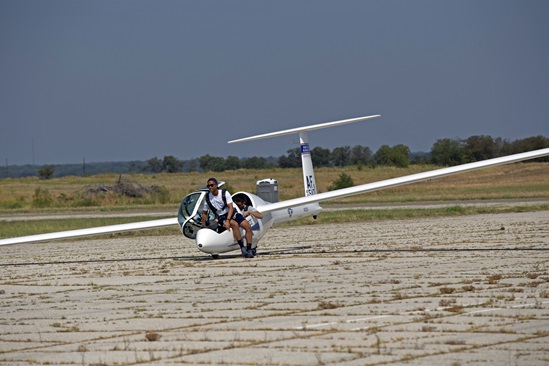Night Glider
Riding the mountain wave after dark
When you’re flying an unusual airplane, you sometimes make unusual requests.
So, the first night J.P. Stewart flew his jet-powered Schempp-Hirth Arcus glider at Manassas Regional Airport (HEF) in Virginia, he asked the tower controller to turn off the airport lights before he approached to land. Stewart was wearing night vision goggles (NVGs), and he didn’t just want the runway and taxiway lights dimmed. He asked the tower controller to completely extinguish them.
“The controller asked me to confirm that I really wanted the lights turned all the way off, —and I assured him that I did,” said Stewart, owner and pilot of the high-performance, self-launching glider that he mostly flies at night. “Once he received that confirmation, he went ahead and killed the lights—and that was a big help to me. I really appreciated it.”
Stewart, 29, is one of fewer than five U.S. glider pilots approved to fly with NVGs. Before landing at night, he could simply remove the goggles and fly visually like other night-flying pilots. But after hours peering through NVGs, his eyes would have had to start adapting to darkness from scratch, and his glider’s avionics are coated with a film that makes them easily readable with NVGs and opaque without them.
“It takes a long time for your eyes to adapt to darkness when you remove NVGs,” he said. “It’s way better to keep wearing them if you can.”
Stewart often flies the German-made Arcus for several hours at a time, and his typical flight profile would be out of the question for just about any other aircraft.

Getting airborne
He straps into the glider’s reclined seat at Manassas, starts its PBS TJ-100 jet engine, and crab-walks along the taxiways with the glider’s main wheel at one edge of the pavement and a much smaller wheel that droops below a wing rolling down the far edge. The glider tilts hard over toward the low-wing side throughout the taxi, and the wing-mounted wheel transmits every crack in the pavement. The Czech-built PBS engine consumes about 14 gallons of jet fuel per hour at idle on the ground at sea level, and the glider only holds 23 gallons, so Stewart tries to get airborne as quickly as possible.
Once cleared for takeoff and aligned with the runway centerline, he adds full power and the jet spits out about 254 pounds of thrust. Initial acceleration is slow, and the ailerons become effective at about 20 knots. Stewart levels the wings with full aileron deflection, then raises the tailwheel with forward stick pressure. The takeoff roll takes about 15 seconds and covers about 1,500 feet on an 80-degree-Fahrenheit evening with a 5-knot headwind. Stewart lifts off at about 60 knots and keeps the glider accelerating in ground effect for the next 1,000 feet, then pitches up about 10 degrees and climbs at 82 KIAS.
He raises the landing gear at 500 feet agl and shallows the climb to 5 degrees as the glider accelerates to 105 KIAS while climbing about 800 fpm.
It takes about 10 miles to escape the Manassas Class D, Washington, D.C., Special Flight Rules Area and the Washington Class B airspace. Then Stewart aims for the Blue Ridge Mountains and shuts down and then retracts the jet engine. When flying under power, the jet engine is amazingly smooth, and the faster it goes, the more powerful it gets. When Stewart shuts it down, the noise level inside the aircraft goes from a banshee shriek to calm and quiet, and the two Bose ANR headsets are no longer necessary.
“Night is very good for soaring, even without thermals...There’s mechanical lift, convergence, and mountain wave. A self-powered glider with turbine reliability puts all of that within reach.”
–J.P. Stewart
The sun is setting and the outside air temperature is dropping, so there’s no rising air from thermals for the glider to ride upward. But steady northwest winds hitting the Appalachians provide ridge lift on the western side of the mountain chain. And the passage of cold fronts with powerful winds can create mountain waves capable of lifting gliders into the flight levels during day or night.
Stewart says the NVGs allow him to fly close to ridges where mechanical lift provides strong updrafts. NVGs have improved dramatically with heightened contrast and depth perception they lacked 25 years ago when military pilots began using them. But they can be cumbersome in the tight confines of the Arcus cockpit, and quick head movements run the risk of distorting views.
This 2017 Arcus has a 50:1 glide ratio, so at 3,000 feet msl, where Stewart typically stows the engine, the glider is within easy gliding range of several airports. And if it encounters sinking air or other adverse flight conditions, its jet engine can power out of just about any predicament.
“Night is very good for soaring, even without thermals,” says Stewart, an aeronautical engineer and Virginia Tech grad who became infatuated with gliders as a teen while earning a Boy Scout aviation merit badge. “There’s mechanical lift, convergence, and mountain wave. A self-powered glider with turbine reliability puts all of that within reach.”
‘Haul ass out of it’
Stewart is vice president and general manager at Electra, a research firm developing extremely short-takeoff-and-landing aircraft that use hybrid electric propulsion. He’s also a glider instructor and commercial fixed-wing pilot with single- and multiengine ratings and a total of roughly 2,000 flight hours.
His jet glider, and three others just like it, came about as the result of an outlandish project by Dennis Tito, an engineer, pilot, and billionaire investor who, in 2001, became the world’s first space tourist by funding his own trip to the International Space Station aboard a Russian Soyuz capsule.
Tito commissioned these specialty gliders to compete in “the online contest,” an ongoing competition among glider pilots around the world who upload their GPS tracks to determine who flies highest, farthest, and longest. Tito deduced high-performance, self-launching, jet gliders located in the Sierra Nevada in North America and the Argentinian Andes in South America would be capable of consistently posting longer, faster, high-altitude flights than anything else, and he set out to prove it. Tito won a series of online contest events in 2016 and 2017 flying these Arcus jets, and he was the overall winner in 2018.
Bob Carlton of Desert Aerospace converted both new and used Arcus motor-gliders to jet power for Tito in Moriarty, New Mexico. Carlton had developed the “Bonus Jet”—a two-seat training glider he used to teach other pilots to operate the PBS TJ-100 engine—and he used the same technology for the jet-powered Arcus J.
“When Dennis gets into something, he jumps all the way in,” Carlton said. “When we started converting the first Arcus, his question to me was, ‘Why don’t we build four?’”
Carlton flew each Arcus for at least five hours during their test periods, which included multiple engine extensions and retractions and in-air restarts. The Arcus J has an exceptionally high never-exceed speed of 200 KTAS. The PBS engines also can be cold-soaked at high altitudes for many hours and then reliably started in the flight levels.
“The Arcus J is the most capable glider in the world,” says Carlton, who is best known among general aviation pilots for performing aerobatic airshow routines in the SubSonex jet. “The Arcus J’s engine reliability is superb. Its control harmony is superb. Best of all, when a weather situation deteriorates, you can haul ass out of it.”
After Tito accomplished his goals for glider competition, he disbanded his team and sold his Arcus J fleet. Two went to Blue Condor, an Airbus-sponsored group developing a hydrogen powerplant. One stayed in Minden, Nevada, where its new owner, Gordon Boettger, has been pushing absolute distance boundaries by flying 1,900 miles or more—day and night—in the powerful mountain waves that form there.
Stewart paid $330,000 for his Arcus J, received flight training in Nevada, took a checkride to obtain an FAA letter of authorization, and became certified to fly with NVGs. Then he brought the glider home to Virginia in its travel trailer.
In the right conditions, the Arcus J can fly all night. In daylight, with the engine stowed, solar panels recharge its battery for the next jet engine start.
“The novelty factor of having a jet-powered glider really appeals to me,” Stewart said. “The more I fly it, the more I learn about its capabilities, the more I want to challenge myself with longer, more ambitious flights.”
Impossibly high and fast
Returning to Manassas to land, Stewart keeps the engine retracted until he’s about two miles from the airport. There’s lots of radio coordination to do with Potomac Approach and Manassas tower, and Stewart adjusts his speed, altitude, and heading to fit into the flow of corporate and training traffic.
Highly effective spoilers atop the wings increase drag and provide instant deceleration. Once the jet engine is extended and started, it provides smooth power and residual thrust, even at idle.
Stewart turns final at 1.5 miles, and the glider seems impossibly high and fast. He’s level at 1,000 feet agl and 120 knots, yet he’s in no hurry to descend or slow down. One mile from the approach end of Runway 34R at 1,000 feet agl, Stewart pops the spoilers, lowers the landing gear and flaps, and reduces engine power to idle. He pushes the nose down about 10 degrees and begins a plunging descent while the airspeed remains steady at 85 knots. Stewart prefers to return to the airport before the control tower closes at 10:30 p.m. because only controllers have the tools to darken the entire airport at once.
“They’re the only ones who can turn off all the airport lights,” he said. “If I land after the tower closes, the lights are sure to be on. With NVGs, the lights can be painfully bright, even when they’re on their dimmest setting.”
Inside the Arcus J, the avionics bathe the cockpit in a green glow and the engine howls as the glider crosses the runway threshold at 80 knots, levels off, and touches down on its main wheel at 60 knots near the 1,000-foot marker. Stewart exits the 6,200-foot runway on the high-speed taxiway just beyond midfield, then lets the glider lean left until the small wheel on the glider’s left wing touches the pavement.
“You’ve got to think carefully about which wing you’re going to lower based on the direction you’re going to turn on the taxiways,” he said. “It’s all just part of the puzzle.”
Stewart says his glider typically consumes about six gallons of jet fuel per flight—and those flights have lasted up to four hours. Stewart brings parachutes and performs graceful but strenuous maneuvers in the Arcus, day or night. He’s gradually building experience in flying the Arcus J with NVGs and getting accustomed to its quirks and unique capabilities: long range, high endurance, extreme efficiency around the clock.
“The aircraft is fully capable of doing all sorts of amazing things,” he said. “Now, it’s a matter of gradually expanding my own skills to take full advantage of them.”










